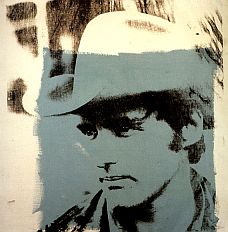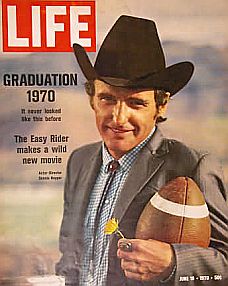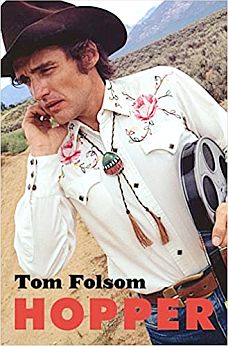
Actor Dennis Hopper shown in one of his Ameriprise Financial television advertisements. Click for sample TV ads.
Others might remember Dennis as the slightly maniacal photojournalist in the Vietnam-era Apocalypse Now of 1979, or the obscenity-spewing wildman Frank Booth in David Lynch’s Blue Velvet of 1986. And then there’s the mad bomber he played in 1994’s Speed with Kenau Reeves and Sandra Bullock, or the villain “Deacon” in Kevin Kostner’s Waterworld of 1995. Or how about the war criminal Victor Drazen in TV’s 24 series of recent years. Not exactly bright and cheery characters.
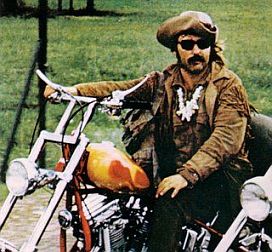
Biker Billy of 'Easy Rider,' a film about financial planning of a different kind. Click for 'Easy Rider' DVD.
“Of course, when you go with a celebrity,” explained Kim Sharan, Ameriprise’s chief marketing officer, “you have to be concerned. … [B]ut we did a significant amount of testing prior to going with Dennis. He tested really well.”
Although Hopper was pitching baby boomers when he made the Ameriprise ads, he himself was not a boomer. He was born in the 1930s, and was then over 70. But according to Doug Pippin, a creative director at Saatchi & Saatchi, the ad agency then doing the Ameriprise ads, baby boomers saw Hopper as “an older brother who’s been out there.” At the time, Pippin called Hopper a “great anti-hero hero,” who stood for “unconventional thinking.”
 |
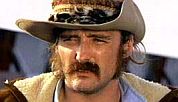 |
 |
 |
 |
 |
Acting Since ’50s
Hopper, in fact, had a long and interesting career. He began acting as a teeanager in the 1950s and later signed with Warner Brothers. During the filming of Rebel Without a Cause — a 1955 film in which he had a small role — he became a friend to James Dean. He also appeared with Dean in Giant (1956), Dean’s last film before his death. By the late 1960s, Hopper teamed up with Peter Fonda and Terry Southern to co-write the 1969 film Easy Rider, which he also directed while playing the role of Billy. That film received two Academy Award nominations — one for a then-unknown Jack Nicholson for Best Supporting Actor and one for Hopper, Fonda, and Southern for Best Original Screenplay. The 1970s were a tough time for Hopper, dealing with alcohol and drug abuse.
In the 1980s, Hopper emerged in successful roles in Blue Velvet (1986) and received an Academy Award nomination for Best Supporting Actor as an alcoholic father trying to help his son’s basketball team in Hoosiers (1986). In 1988 he directed the police vs. street gangs drama Colors with Sean Penn and Robert Duvall. Since then he has directed a few more films, including The Hot Spot (1990) and Chasers (1994). In the 1990s, he became known for playing bad guy roles in films such as Speed (1994). In recent years, he has acted in several TV films and also appeared in TV series such as 24 and E-Ring. Beyond his acting and directing, Hopper is also an accomplished photographer with his work shown publicly and published in several books (see selection below “sources”). He is also a modern art collector.
Hopper has appeared in advertising throughout his career, for Nike and other sponsors. But the work he is now doing for Ameriprise may become one of those classic pieces of advertising history, despite all the criticism of a bad fit. At the very least, the style of the ads is a welcomed change from the more staid approaches of the past. Here’s some history on how it came about.
New Kind of Ad
“Our new campaign is a radical departure from standard financial services advertising,” said Ameriprise’s Kim Sharan at the launch of their ads in September 2006. “We are firmly focused on the positive aspects of retirement and our understanding that boomers aren’t going to spend this phase of life playing shuffleboard. There is no better figure to personify our message than legendary actor Dennis Hopper who embodies the spirit of the generation. With his help we are speaking with boomers not at them.”
Ameriprise — formerly a major division of American Express — became an independent company in August 2005 when it was spun off from American Express as a separate company. At the time, it was the sixth largest such roll out in corporate history. Today it is a stand-alone Fortune 500 company in its own right, ranked at #296 in May 2008, the fourth largest financial advisory firm in the U.S.
When Ameriprise became its own company, it needed to tell the world who it was and what it did, and so it began a “brand awareness” campaign. It also wanted to increase its business, add to the amount of assets under its management, and hold on to its advisor network. A marketing plan and advertising campaign were included. And that’s where Dennis Hopper comes in.
Studying Boomers
As Ameriprise began its new life as an independent, the financial services industry was in a major battle for the hearts, minds, and retirement money of the 78 million baby boomers now entering their 60s. At stake is more than $2 trillion in IRA and other assets that boomers now hold. Needless to say, companies like Fidelity, Merrill Lynch, and Ameriprise are, as one report put it, “salivating in anticipation” over this wealth. At stake is more than $2 trillion in IRA and other assets that boomers now hold. In the last few years, these and other firms have been spending some $700 million a year trying to capture boomer’s business. For Ameriprise, the question became how best to do that.
Ameriprise and its marketers began studying boomers. Using focus groups and other techniques, they met with boomers all across the country, taking their measure. They found a “work hard/play hard” cohort who were still rebels in a sense, and were not into passive retirement. Boomers are looking forward to the “next act” of their lives, but don’t want to be lectured about money and financial planning. From this, Ameriprise gleaned that “dreams” might be a good peg. Or as they put it: “We knew that we had to quell [boomers’] dread of financial planning and replace it with hope. We challenged our creative teams to take the focus off money and help boomers realize their dreams.”
Finding Their Man
In designing creative strategies, an “unexpected idea” of featuring Dennis Hopper in TV advertising arose. This came as part of the ad agency’s recommendation to use someone who was a leader or otherwise prominent in the 1960s counterculture. But the Hopper recommendation came as “a surprise” to the company. The only other celebrity used in financial services advertising at the time was Sam Waterston, who then played a righteous lawyer and prosecutor on the TV show, Law & Order. Ameriprise officials were not real comfortable with the prospect of using Hopper for their ads. Surely there must be other actors to consider, they suggested. “The Agency tried to think of some alternatives,” says one Ameriprise account of the process, “and that’s how we began to realize just how perfect and incomparable Dennis Hopper is.”Survey: “Baby Boomers saw Hopper as extremely talented, willing to chal- lenge himself, uncompro- mising, and just really cool.”
Still, Hopper was tested with audiences along with another unspecified alternative campaign. Here’s the report on what Ameriprise and their ad agency found:
“The two campaigns were taken to four markets for evaluation via one-on-one interviews. A consistent pattern of consumer response emerged. The concept featuring Dennis Hopper was clearly more appealing, in a big West Coast market as well as a smaller “Middle America” market. “Baby Boomers saw Hopper as extremely talented, willing to challenge himself, uncompromising, and just really cool. He is someone they look up to and aspire to emulate his values.”
“Meanwhile, we purchased syndicated celebrity research from E-Score (a more robust competitor to the well-known Q Score). The data reinforced what the qualitative research had demonstrated. Hopper had the combination of winning attributes that were consistent with Ameriprise’s desired brand personality: versatile, talented, experienced, intriguing, especially among our target audience.”
When they tested Dennis Hopper TV concepts, they also found a positive response. “When the Hopper spots tested above norm in quantitative testing, Ameriprise knew that Hopper was their guy.” All of the research, focus groups, and testing helped convince Ameriprise management that provocative ads featuring Dennis Hopper “could have significant positive impact on their business.” So the ads went forward, the first released in September 2006.
Hopper & ’60s Music

Hopper pitching Ameriprise.
The ads are emotionally powered by a 1960s’ song from the Spencer Davis Group, using a signature organ riff that is a guaranteed “boomer getter”.
Each of the Ameriprise ads features Hopper dressed in black with his symbolic red chair (the “anti-rocking chair”). But most important is the music, as each of the 30-second spots is emotionally powered by the same classic piece of 1960s’ music. The song used is by Steve Winwood and the Spencer Davis Group, called “Gimme Some Lovin’ “(#7, 1967). It’s a landmark piece with a distinctive beat and signature organ riff that are immediately recognized by anyone who was even remotely paying attention in the 1960s. It also has guaranteed “kitchen-to-TV-room” drawing power for those who might have drifted away from their TV sets. The music almost has a “Pied Piper” effect on folks of that era. The tune plays prominently and at key moments in each of the ads as Dennis tells his viewers they “need a plan.” In fact, without the Spencer Davis song, these ads would be considerably less effective, as one You Tube clip without the music shows.
Curiously, at one point after the ads had run for a time, Ameriprise stopped using the Spencer Davis music with the ads and began using other music. A narrative sampling of four of the Ameriprise ads using the original Spencer Davis music, follows below. The videos with the newer music were posted earlier at the Ameriprise website.
“Wildflower”
This ad opens with a close up of Dennis in the middle of big field of sunflowers, dressed in his black shirt, twirling a single flower in his hand as he talks directly to the viewer: “Some people say that dreams are like delicate little flowers. WRONG!” Cue Spencer Davis tune and pan out to wide view of whole field and Dennis tossing the flower into the air. “Dreams are powerful,” says Dennis, now in close-up mode talking with the viewer while using emphatic hand gestures. “Dreams are what make you say, ‘When I’m 64, I’m going to start a new business; I want to make my own movie’.” “Flower power was then, your dreams are now.” Then, with some finger pointing, he adds, “But powerful dreams need more than just a little weekend gardening.” Cut to beautiful Southwest desert scene with assorted tall cacti and attractive gray-haired lady taking in the beauty, then to scenes with husband and a financial planner sitting down going over some paperwork. Then cut to attractive adobe-like building in the desert — i.e., dream realized, home in the desert — as voiceover explains: “Start with your dreams, and your Ameriprise Financial advisor, through a unique approach called Dream, Plan, Track ( these words flash on screen, along with “Go To What’s Next” and “ameriprise.com”). We’ll work with you to help make your dreams realities.” Cut back to Dennis in the field of sunflowers, close up: “Flower power was then, your dreams are now.” Close: Ameriprise logo and lettering flash on screen with 1-800-Ameriprise phone number.
“American Dreams”

. . . in American Dreams ad.
“Salt Flats”
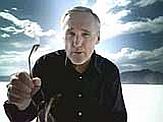
Dennis Hopper in ad.
“Stars”

Hopper in 'Stars' ad.

Hopper with dictionary.

Other Ameriprise ad.
Over the lifetime of the Dennis Hopper/Ameriprise ad series — which is still ongoing as of June 2008 — the ads have appeared on a variety of network and cable TV shows, including: NBC Sunday Night Football, LOST, Extreme Makeover: Home Edition, Desperate Housewives, CSI: Miami, Without a Trace, and others. There have also been print, radio, and online components to the campaign.
Catching Flak
Ameriprise landed a share of criticism for these ads, both in the blogosphere and from mainstream media critics, some taking shots at the use of Hopper in particular. Bob Garfield of Advertising Age — after offering a qualifying aside that “those ’60s dreams weren’t about bond yields and beach houses” — didn’t think Hopper was the right messenger. The casting of Hopper, he said “presumes that all leading-edge boomers identify with, or at least fondly recall Hopper’s transgressive roles and his generally schizoid persona. “This was a big mistake, said Garfield. “Not everyone from 1969 wanted to stick it to The Man.” Most boomers, he said, were not revolutionaries beyond bell bottoms and Rowan & Martin’s Laugh In. Bob Garfield of Advertis- ing Age noted that “those ’60s dreams weren’t about bond yields and beach houses.” The Establishment survived, he explained, and so “a fringe character like Hopper isn’t necessarily symbolic of his generation. Joni Mitchell would be a better choice.” Garfield noted that Hopper’s off-screen life “hadn’t been especially orderly, either.”
The ad also failed its sponsor, charged Garfield, for not explaining the brand, Ameriprise, which few people then knew. “This spot is a classic example of Saatchi & Saatchi, New York, falling so in love with star power that it neglects the brand itself.” Still, Garfield conceded the spot was better than most financial planning advertising fare — “not like some brain-dead, condescending pitch… to an audience of presumably doddering old fools.” Could it be, Garfield wondered, that baby-boomers might be the first retirement age group “to be treated by Madison Avenue with dignity?” Explaining how Mad Ave normally did this kind of pitch, Garfield wrote: “One day you’re a vibrant worker with responsibility, income and possibly even a sex life and — wham — the next you’re a fearful dullard, being insultingly spoken down to by the very people who want your business.” So for Garfield, although Hopper may not have been the right icon, “we’re just thrilled it wasn’t Aunt Bea.”
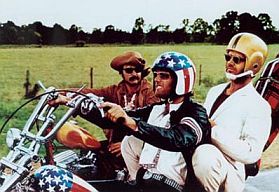
'Easy Riders' - from left: Hopper, Fonda & Nicholson.
“LSD-Fueled Hippie”
Diane Rohde, writing for The Onion.com in late May 2007, had some satirical fun with Hopper’s screen personas: “Retirement planning means a lot of decision making, and thank God I have the soothing presence of that amyl nitrite-huffing, obscenity-screaming, psychosexual lunatic from Blue Velvet to guide me through it.” She also added, “I’m sure that Dennis Hopper wouldn’t represent a company that was anything other than a rock of respectability. When I hear him in those commercials, it’s the familiar voice of a coke-dealing, LSD-fueled hippie cowboy biker putting me at ease….” In addition to the print send-ups, there were also a number of Dennis Hopper /Ameriprise video parodies that ran on You Tube and other sites — some quite hilarious. But others, such as blogger Lewis Green, liked the ad and thought it an effective way to reach boomers.
Hitting Their Mark
By late February 2007, the ads seemed to be hitting their mark — or at least some of them. USA Today found that the Ameriprise ads scored low overall with adults generally who were surveyed by its Ad Track weekly poll at that time. However, the target audience of boomer-age consumers generally had higher scores. About 50 percent of the boomers liked the ads “a lot” or “somewhat,” and 79 percent rated the ads “very effective” or “somewhat effective.”
“We know that these ads are striking a chord,” said Ameriprise’s Kim Sharan in February 2007. “Financial services is a pretty staid field, so we wanted to bring a tone and personality that is more emotionally driven.” Even the criticism is a good sign, according to Sharan.“We know that these ads are striking a chord,” said Ameriprise’s Kim Sharan, who added later, “… and in some ways is becoming part of our culture.” The Ameriprise website received an uptick in hits after the Onion.com piece appeared n May 2007, according to Sharan. That “shows our message is out there,” she said. “It’s resonating, and in some ways is becoming part of our culture.”
In August 2007, Ameriprise and its ad agency Saatchi & Saatchi launched a second wave of Dennis Hopper ads. This round of TV advertising was accompanied by spots on the Web, and Ameriprise also paired with National Geographic to do some videos of people fulfilling their dreams who are aided by Ameriprise advisers. The company is hoping these efforts will go beyond boomers, and appeal as well to Generation-X. Ameriprise spent $110 million on advertising in 2006, according to the Nielsen Co., and about that much again in 2007. The second round of Hopper ads began their run in late 2007 early 2008 and as of June 2008 were still appearing.
The Results

'Palm Springs Magazine,' March '07.
In partial summary, the company also offered this perspective:
“The new campaign was an opportunity to position Ameriprise in a way that no brand in the category had done before. The antithesis of the stodgy and outdated financial services company, Ameriprise brought to life the independent, irreverent, and optimistic character of the Boomer generation.
We used our television executions to inspire Boomers to start dreaming. The spots featured anti-hero Dennis Hopper riffing about dreams and their indelible power. Introducing a new vocabulary to the financial services world, the spots shifted the focus of retirement away from numbers. Hopper became a trustworthy advocate for Boomer dreams in a way that only he could. . .”
In April 2008, at an awards ceremony in New York, the Advertising Research Foundation awarded both its top-place Grand Ogilvy advertising award and the Gold Award for Financial Services to Ameriprise Financial for its multimedia national ‘Dreams Don’t Retire’ campaign.
As for Dennis Hopper, one can’t help but think that he had some fun making these commercials, and that he also had a few laughs in the process — including those on the way to the bank.
See also at this website the “Madison Avenue” page for more stories related to advertising and marketing, or the “Film & Hollywood” page for stories in that category. Thanks for visiting – and if you like what you find here, please make a donation to help support the research and writing at this website. Thank you. – Jack Doyle
|
Please Support Thank You |
____________________________________
Date Posted: 17 June 2008
Last Update: 30 January 2021
Comments to: jdoyle@pophistorydig.com
Article Citation:
Jack Doyle, “Dennis Does Ameriprise, 2006-2008,”
PopHistoryDig.com, June 17, 2008.
____________________________________
Sources, Links & Additional Information
Ameriprise Financial, Inc., Minneapolis, MN, Press Release, “New Evolution of Ameriprise Financial Advertising Emphasizes that “Dreams Don’t Retire”; Broadcast Ads Feature Actor Dennis Hopper and A 1960s-Style Red Chair,” September 7, 2006.
Bob Garfield, “Ameriprise’s Dennis Hopper Spot: Wrong Icon, Right Tone – Saatchi & Saatchi Work Hypes Star, Neglects Brand,” Advertising Age.com, November 19, 2006.
Laura Petrecca, “More Marketers Target Boomers’ Eyes, Wallets, USA Today, February 25, 2007.
“Dennis Hopper,” Wikipedia.org.
“Dennis Hopper – Biography,” Biography.com, A&E Television Networks, 2007.
“Dennis Hopper,” Great Movie Actors at Movie Actors.com.
Diane Rohde, “There’s No More Reassuring Voice In Retirement Planning Than Dennis Hopper,” The Onion.com, May 30, 2007 | Issue 43•22.
Ameriprise Financial, Inc., “Online Strategy Plays a Primary Role in New Evolution of Ameriprise Financial Advertising – New television spots air tonight on ESPN Monday Night Football,” Business Wire, September 10, 2007.
Kara McGuire, “Glutton for Abuse, Or Marketing Genius?,” Star Tribune (Minneapolis, MN), September 30, 2007.
Case Study, “Ameriprise Financial,” The ARF David Ogilvy Awards, 2008 Grand Ogilvy Winner, citing sources including, Ameriprise Financial 3rd Quarter 2007 Earnings Report, 5 pp.
John Morgan, “Ameriprise Dreams Don’t Retire’ Campaign Wins Grand Ogilvy Award,” Money Management Executive, April 7, 2008.
Quantitative Tracking Data, Ameriprise Financial, 3rd Quarter 2007, Earnings Report.
Lewis Green, “Who Are Today’s Boomer Consumers?,” Marketing Profs Daily Fix Blog, March 22, 2007, MPDailyFix.com.
Andy Warhol Polaroids and silk screens of Dennis Hopper have appeared at selected museums and variously on the web, such as: California State University, Long Beach; and, the Kemper Museum of Contemporary Art, Kansas City, Missouri.

